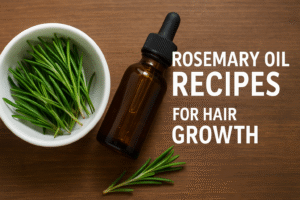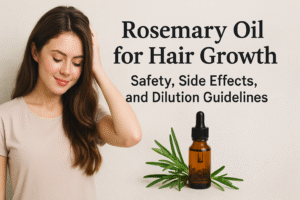If you’ve ever searched for natural ways to support healthier, fuller hair, chances are you’ve come across countless people recommending rosemary oil. Over the past few years, interest in how to use rosemary oil for hair growth has skyrocketed—not just in beauty blogs but also in scientific studies and dermatology discussions. And for good reason.
Rosemary essential oil isn’t a discovery. It has been used for centuries in Mediterranean cultures as a multipurpose remedy for scalp health, circulation, and even memory support. What’s changed today is that modern research is starting to validate what traditional medicine always hinted at: rosemary oil may actually stimulate hair follicles, improve blood flow to the scalp, and reduce common concerns like dandruff and thinning.
Unlike harsh chemical treatments, rosemary oil offers a more natural remedy for hair loss. It belongs to the family of essential oils for hair growth that many people now use as a first step before trying prescription solutions. With benefits that extend beyond hair—think scalp soothing, anti-inflammatory effects, and antioxidant support—rosemary oil has become a go-to in the natural hair care world.
Science Behind Rosemary Oil and Hair Growth
When people ask how to use rosemary oil for hair growth, the first question that comes up is: Does it really work? The answer lies in the plant’s unique chemistry. Rosemary essential oil is rich in active compounds such as 1,8-cineole, rosmarinic acid, and camphor. These compounds are known for their ability to improve circulation, fight inflammation, and act as antioxidants—all of which create a healthier environment for your hair follicles.
One of the biggest advantages of rosemary oil is its effect on scalp microcirculation. By increasing blood flow, it delivers more oxygen and nutrients to the hair roots, which may encourage stronger, thicker growth. It also has antimicrobial properties that help reduce dandruff, irritation, and excess sebum—all common barriers to healthy hair. This is why many experts highlight rosemary oil benefits for scalp health alongside its growth-promoting potential.
But perhaps the most compelling evidence comes from research comparing rosemary oil vs minoxidil, a well-known treatment for hair loss. In a six-month clinical trial, people using rosemary oil showed hair regrowth results similar to those using 2% minoxidil, with fewer side effects like scalp itching. For anyone seeking a natural alternative to pharmaceutical treatments, that’s a persuasive finding.
So, while rosemary oil won’t transform your hair overnight, consistent use may support long-term follicle health. Combined with the right application methods, this simple essential oil can stand shoulder to shoulder with proven hair loss treatments.
How to Use Rosemary Oil for Hair Growth (Step-by-Step Guide)
If you’re wondering how to use rosemary oil for hair growth, the key is consistency, proper dilution, and choosing the right application method for your lifestyle. Unlike one-time treatments, natural remedies like rosemary essential oil work gradually, so you’ll need to make it part of your regular hair care routine. Here are the most effective ways to use it:
1. Scalp Massage with Diluted Rosemary Oil
Why it works: Direct scalp massage increases circulation and allows rosemary’s active compounds to penetrate hair follicles.
How to do it: Mix 3–6 drops of rosemary essential oil with 1 tablespoon of a carrier oil (like jojoba, coconut, or argan). This creates a safe rosemary oil dilution ratio for scalp use (about 2–3%). Massage into your scalp for 5–10 minutes, two to three times a week. Leave it on for at least 30 minutes before washing, or overnight if your skin tolerates it.
2. Add to Shampoo or Conditioner
For a quick method, add 3–5 drops of rosemary oil to each ounce of shampoo or conditioner. Shake well before use. This creates a mild, daily application that can help maintain scalp health and reduce dandruff. Many people call this the “DIY rosemary oil shampoo” method.
3. Rosemary Water Rinse
Another simple option is a herbal hair rinse. Add a few drops of rosemary essential oil to a cup of warm water, stir well, and pour over your scalp after shampooing. This rosemary water hair rinse helps soothe irritation and refresh the scalp without leaving an oily residue.
4. DIY Scalp Tonic or Serum
For a more intensive treatment, blend rosemary oil with other essential oils for hair growth (like peppermint or lavender) in a carrier oil base. Apply to the scalp before bed, two to three nights a week. This DIY scalp tonic can be tailored to target dandruff, thinning, or dryness, depending on the oils you mix.
Rosemary Oil Recipes for Hair Growth
Once you know how to use rosemary oil for hair growth, the next step is learning simple, effective recipes you can make at home. These blends allow you to target specific concerns—like dandruff, thinning, or dryness—while making the most of rosemary essential oil’s natural properties.
1. Pre-Shampoo Scalp Massage Blend
Best for overall growth support
2 tablespoons jojoba or coconut oil (carrier oil)
6 drops rosemary essential oil
2 drops lavender essential oil (optional, for calming effect)
Massage into your scalp for 5–10 minutes, leave on for 30–60 minutes, then wash with a gentle shampoo. Regular use of this recipe not only supports growth but also nourishes the scalp.
2. Anti-Dandruff Hair Oil
Best for dandruff and hair fall
2 tablespoons coconut oil
5 drops rosemary essential oil
3 drops tea tree oil (powerful antifungal)
This blend is particularly helpful if dandruff and itching are part of your hair loss problem. Apply twice a week as a scalp treatment. The antimicrobial synergy helps control flakes while rosemary improves circulation.
3. DIY Rosemary Oil Serum for Daily Use
Best for leave-in scalp and strand protection
2 tablespoons argan oil (lightweight carrier oil)
4 drops rosemary essential oil
2 drops peppermint oil (stimulating, cooling effect)
Place the mixture in a dropper bottle. Apply a few drops directly to the scalp and massage gently. This light rosemary essential oil serum can be used more frequently without making hair greasy.
4. Rosemary Water Rinse Infusion
1 cup warm distilled water
5–6 drops rosemary essential oil
Mix well, then pour over the scalp after shampooing as a final rinse. This recipe is perfect for those who prefer a non-oily option and want a refreshing, herbal boost.

Rosemary Oil vs Minoxidil: Which Works Better?
When discussing how to use rosemary oil for hair growth, one question that often comes up is how it compares to minoxidil, the most widely used over-the-counter treatment for hair loss. Minoxidil has decades of research behind it, but not everyone tolerates it well—common complaints include scalp irritation, dryness, and itching. That’s where rosemary essential oil enters the conversation as a natural alternative.
A notable six-month clinical trial compared rosemary oil vs minoxidil (2%) in people with androgenetic alopecia, the most common form of hair thinning. Surprisingly, both groups experienced similar improvements in hair count. The biggest difference? Rosemary users reported far fewer side effects, particularly less scalp irritation.
So why might rosemary oil be effective? Its anti-inflammatory and antioxidant properties help create a healthier scalp environment, while its ability to improve circulation supports nutrient delivery to follicles. These mechanisms align with many of the rosemary oil benefits for scalp health already documented in traditional and modern use.
Does that mean rosemary oil can replace minoxidil entirely? Not quite. Minoxidil remains the gold standard in conventional dermatology, with robust evidence and FDA approval. However, for those seeking a natural alternative to minoxidil for hair loss or wanting to complement medical treatments with a gentler option, rosemary oil is an excellent place to start.
In short, while results may vary from person to person, rosemary oil has proven itself as more than just a folk remedy—it’s a legitimate contender in the conversation about effective hair growth solutions.
Safety, Side Effects, and Dilution Guidelines
Learning how to use rosemary oil for hair growth isn’t just about recipes and routines—it’s also about using it safely. While rosemary essential oil is generally well-tolerated, it is highly concentrated and must always be diluted before applying to the scalp.
Dilution Guidelines
The standard rosemary oil dilution ratio for scalp applications is 2–3%. In practical terms, that means adding 3–6 drops of rosemary essential oil to 1 tablespoon (about 15 ml) of a carrier oil such as jojoba, coconut, or argan. These carrier oils for essential oil blends not only reduce irritation but also add nourishing fatty acids that benefit scalp and hair health.
Possible Side Effects
Most users experience no problems, but a few may notice mild redness, tingling, or itching after application. These are signs of sensitivity or using too high a concentration. Always do a patch test on a small area of skin before applying rosemary oil more broadly.
Who Should Avoid Rosemary Oil?
Pregnant or breastfeeding women should consult a healthcare provider before use.
Children under six should not use essential oils directly on the scalp.
People with epilepsy or high blood pressure are sometimes advised to avoid stimulating oils, including rosemary.
Bottom Line
When diluted properly and applied consistently, rosemary oil is safe for most people. Respecting dilution guidelines and watching for early signs of irritation ensures you’ll enjoy the benefits without unwanted side effects.

Buying Guide: Choosing the Best Rosemary Essential Oil
Once you’ve learned how to use rosemary oil for hair growth, the next step is making sure you’re using a high-quality product. Not all essential oils are created equal, and a poor-quality oil won’t deliver the same scalp or hair benefits.
When shopping, look for 100% pure rosemary essential oil with no added fillers, synthetic fragrances, or carrier oils mixed in. The label should list Rosmarinus officinalis as the botanical name. Reputable brands often provide GC/MS tested reports (gas chromatography/mass spectrometry), which verify the purity and chemical profile of the oil. If the company shares a certificate of analysis (COA), that’s an excellent sign of transparency.
Packaging matters too. Essential oils are best stored in dark amber or cobalt glass bottles to protect them from light and oxidation. Avoid plastic containers, which can degrade over time.
Finally, price can be a good indicator. While rosemary oil is not one of the most expensive essential oils, very cheap options are often diluted or adulterated. Aim for a mid-range price point from trusted aromatherapy or natural health brands.
By following this essential oil buying guide, you’ll ensure that the rosemary oil you use is both safe and effective, maximizing its potential to support hair growth.
Conclusion: Unlocking the Power of Rosemary Oil for Hair Growth
If you’ve been searching for a natural, effective way to support thicker, healthier hair, learning how to use rosemary oil for hair growth may be the solution you need. Backed by both traditional use and emerging scientific research, rosemary essential oil offers a safe, affordable, and versatile approach to improving scalp health and encouraging new growth.
The key lies in consistency. Whether you massage it into your scalp with a nourishing carrier oil, add it to your shampoo, or use it as part of a weekly overnight mask, rosemary oil works best when applied regularly over time. Most people start to notice improvements in shedding, strength, and hair density within a few months.
By selecting a high-quality, pure essential oil and adhering to safe dilution practices, you can confidently incorporate rosemary oil into your hair care regimen. It’s a simple, natural remedy with big potential—one that can help restore confidence along with healthier, fuller-looking hair.
FAQs:
- How do I apply rosemary oil to my scalp?
To use rosemary oil for hair growth, dilute 3–6 drops of essential oil in 1 tablespoon of a carrier oil (like jojoba, coconut, or argan). Massage the blend into your scalp for 5–10 minutes, then leave it on for at least 30 minutes before washing your hair. For best results, repeat 2–3 times per week. - Can I apply rosemary oil directly without dilution?
It’s not recommended. Rosemary essential oil is highly concentrated and can cause irritation or dryness if applied directly to the scalp. Always dilute it with a carrier oil to keep your scalp healthy and comfortable. - How long does it take to see results?
Hair growth is a slow process. Most people who consistently use rosemary oil for thinning hair notice changes in 3–6 months. Results can include reduced shedding, stronger strands, and the appearance of new baby hairs along the hairline. - Can rosemary oil help with dandruff or an itchy scalp?
Yes. Rosemary oil’s antimicrobial and anti-inflammatory properties make it useful for soothing dandruff, flakes, and itchiness. Mixing it with coconut oil—a natural antifungal—can enhance its scalp-cleansing effects. - What’s the best carrier oil to mix with rosemary oil?
It depends on your hair type:
Coconut oil – great for dry scalps and damaged hair.
Jojoba oil – closest to the scalp’s natural sebum, lightweight, and non-greasy.
Argan oil – ideal for frizz control and extra shine.
- Can I leave rosemary oil on overnight?
Yes, as long as it’s diluted. Many people find that leaving it overnight as a scalp mask helps maximize absorption. Just remember to wash it out in the morning to avoid buildup.

